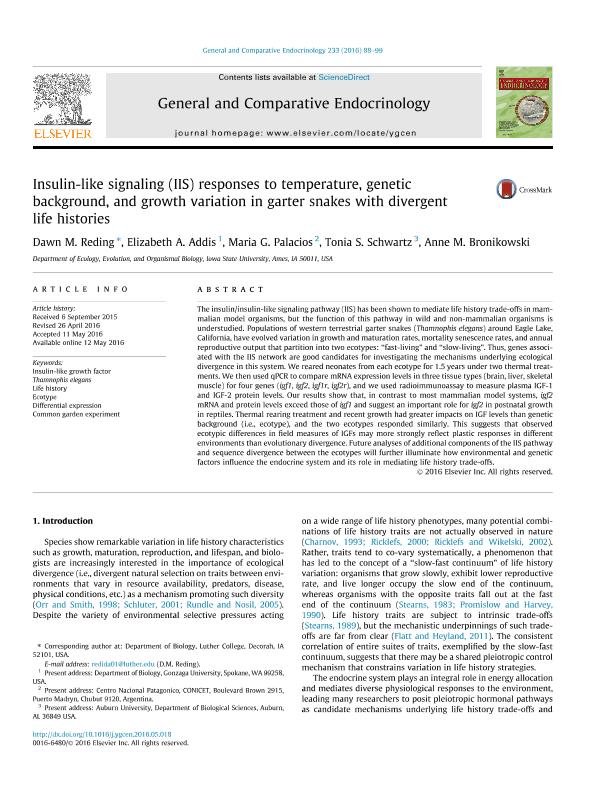Mostrar el registro sencillo del ítem
dc.contributor.author
Reding, Dawn
dc.contributor.author
Addis, Elizabeth A.
dc.contributor.author
Palacios, María Gabriela

dc.contributor.author
Schwartz, Tonia S
dc.contributor.author
Bronikowski, Anne M
dc.date.available
2017-09-22T18:37:24Z
dc.date.issued
2016-07-01
dc.identifier.citation
Reding, Dawn; Addis, Elizabeth A.; Palacios, María Gabriela; Schwartz, Tonia S; Bronikowski, Anne M; Insulin-like signaling (IIS) responses to temperature, genetic background, and growth variation in garter snakes with divergent life histories; Academic Press Inc Elsevier Science; General and Comparative Endocrinology; 233; 1-7-2016; 88-99
dc.identifier.issn
0016-6480
dc.identifier.uri
http://hdl.handle.net/11336/24951
dc.description.abstract
The insulin/insulin-like signaling pathway (IIS) has been shown to mediate life history trade-offs in mammalian model organisms, but the function of this pathway in wild and non-mammalian organisms is understudied. Populations of western terrestrial garter snakes (Thamnophis elegans) around Eagle Lake, California, have evolved variation in growth and maturation rates, mortality senescence rates, and annual reproductive output that partition into two ecotypes: ‘‘fast-living” and ‘‘slow-living”. Thus, genes associated with the IIS network are good candidates for investigating the mechanisms underlying ecological divergence in this system. We reared neonates from each ecotype for 1.5 years under two thermal treatments. We then used qPCR to compare mRNA expression levels in three tissue types (brain, liver, skeletal muscle) for four genes (igf1, igf2, igf1r, igf2r), and we used radioimmunoassay to measure plasma IGF-1 and IGF-2 protein levels. Our results show that, in contrast to most mammalian model systems, igf2 mRNA and protein levels exceed those of igf1 and suggest an important role for igf2 in postnatal growth in reptiles. Thermal rearing treatment and recent growth had greater impacts on IGF levels than genetic background (i.e., ecotype), and the two ecotypes responded similarly. This suggests that observed ecotypic differences in field measures of IGFs may more strongly reflect plastic responses in different environments than evolutionary divergence. Future analyses of additional components of the IIS pathway and sequence divergence between the ecotypes will further illuminate how environmental and genetic factors influence the endocrine system and its role in mediating life history trade-offs.
dc.format
application/pdf
dc.language.iso
eng
dc.publisher
Academic Press Inc Elsevier Science

dc.rights
info:eu-repo/semantics/openAccess
dc.rights.uri
https://creativecommons.org/licenses/by-nc-sa/2.5/ar/
dc.subject
Insulin-Like Growth Factor
dc.subject
Thamnophis Elegans
dc.subject
Life History
dc.subject
Ecotype
dc.subject
Differential Expression
dc.subject
Common Garden Experiment
dc.subject.classification
Bioquímica y Biología Molecular

dc.subject.classification
Ciencias Biológicas

dc.subject.classification
CIENCIAS NATURALES Y EXACTAS

dc.title
Insulin-like signaling (IIS) responses to temperature, genetic background, and growth variation in garter snakes with divergent life histories
dc.type
info:eu-repo/semantics/article
dc.type
info:ar-repo/semantics/artículo
dc.type
info:eu-repo/semantics/publishedVersion
dc.date.updated
2017-06-30T13:28:57Z
dc.journal.volume
233
dc.journal.pagination
88-99
dc.journal.pais
Estados Unidos

dc.journal.ciudad
New York
dc.description.fil
Fil: Reding, Dawn. Luther College. Department of Biology; Estados Unidos
dc.description.fil
Fil: Addis, Elizabeth A.. Gonzaga University; Estados Unidos
dc.description.fil
Fil: Palacios, María Gabriela. Consejo Nacional de Investigaciones Científicas y Técnicas. Centro Científico Tecnológico Conicet - Centro Nacional Patagónico; Argentina
dc.description.fil
Fil: Schwartz, Tonia S. Auburn University; Estados Unidos
dc.description.fil
Fil: Bronikowski, Anne M. Iowa State University; Estados Unidos
dc.journal.title
General and Comparative Endocrinology

dc.relation.alternativeid
info:eu-repo/semantics/altIdentifier/doi/http://dx.doi.org/10.1016/j.ygcen.2016.05.018
dc.relation.alternativeid
info:eu-repo/semantics/altIdentifier/url/http://www.sciencedirect.com/science/article/pii/S0016648016301393
Archivos asociados
